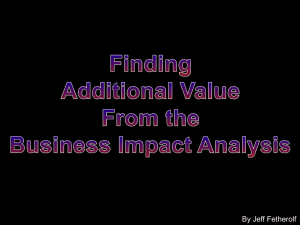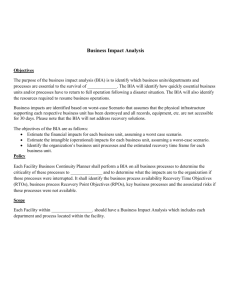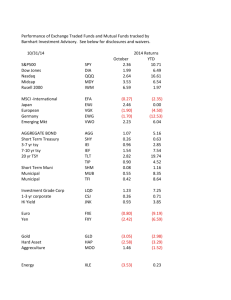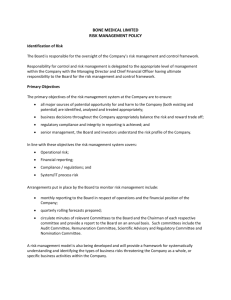The Business Impact Analysis (BIA) has long
advertisement
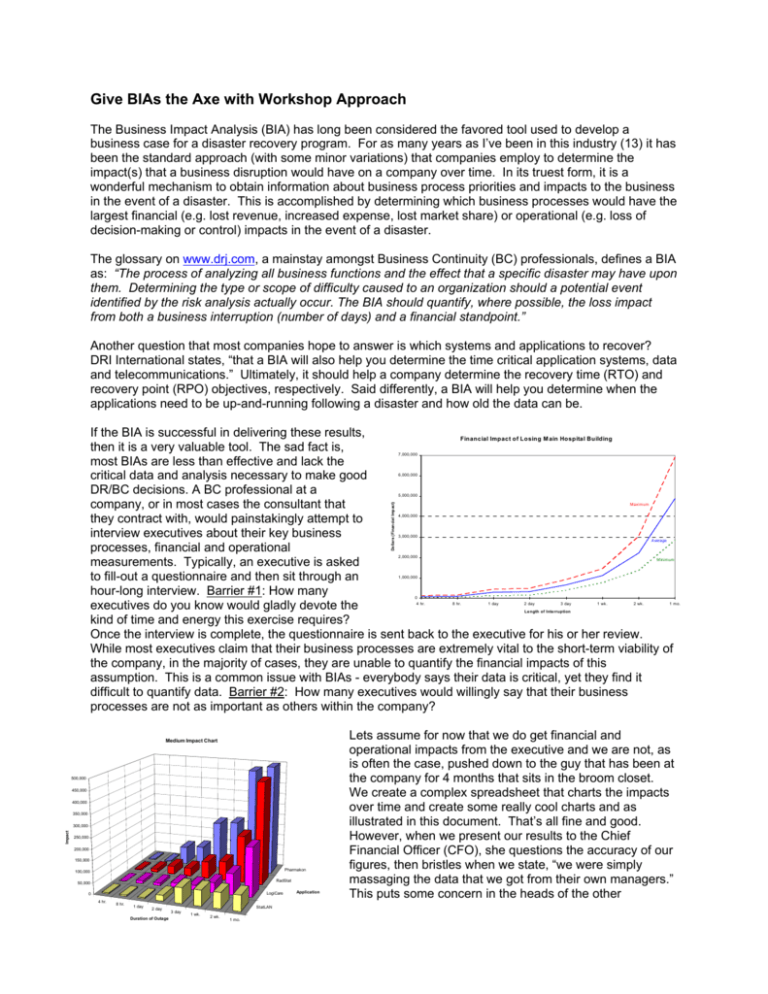
Give BIAs the Axe with Workshop Approach The Business Impact Analysis (BIA) has long been considered the favored tool used to develop a business case for a disaster recovery program. For as many years as I’ve been in this industry (13) it has been the standard approach (with some minor variations) that companies employ to determine the impact(s) that a business disruption would have on a company over time. In its truest form, it is a wonderful mechanism to obtain information about business process priorities and impacts to the business in the event of a disaster. This is accomplished by determining which business processes would have the largest financial (e.g. lost revenue, increased expense, lost market share) or operational (e.g. loss of decision-making or control) impacts in the event of a disaster. The glossary on www.drj.com, a mainstay amongst Business Continuity (BC) professionals, defines a BIA as: “The process of analyzing all business functions and the effect that a specific disaster may have upon them. Determining the type or scope of difficulty caused to an organization should a potential event identified by the risk analysis actually occur. The BIA should quantify, where possible, the loss impact from both a business interruption (number of days) and a financial standpoint.” Another question that most companies hope to answer is which systems and applications to recover? DRI International states, “that a BIA will also help you determine the time critical application systems, data and telecommunications.” Ultimately, it should help a company determine the recovery time (RTO) and recovery point (RPO) objectives, respectively. Said differently, a BIA will help you determine when the applications need to be up-and-running following a disaster and how old the data can be. If the BIA is successful in delivering these results, Financial Impact of Losing M ain Hospital Building then it is a very valuable tool. The sad fact is, most BIAs are less than effective and lack the critical data and analysis necessary to make good DR/BC decisions. A BC professional at a company, or in most cases the consultant that they contract with, would painstakingly attempt to interview executives about their key business processes, financial and operational measurements. Typically, an executive is asked to fill-out a questionnaire and then sit through an hour-long interview. Barrier #1: How many executives do you know would gladly devote the kind of time and energy this exercise requires? Once the interview is complete, the questionnaire is sent back to the executive for his or her review. While most executives claim that their business processes are extremely vital to the short-term viability of the company, in the majority of cases, they are unable to quantify the financial impacts of this assumption. This is a common issue with BIAs - everybody says their data is critical, yet they find it difficult to quantify data. Barrier #2: How many executives would willingly say that their business processes are not as important as others within the company? 7,000,000 6,000,000 Dollars (Financial Impact) 5,000,000 Maximum 4,000,000 3,000,000 Average 2,000,000 Minimum 1,000,000 0 4 hr. 8 hr. 1 day 2 day 3 day 1 wk. 2 wk. 1 mo. Length of Interruption Medium Impact Chart 500,000 450,000 400,000 350,000 Impact 300,000 250,000 200,000 150,000 Pharmakon 100,000 RadStat 50,000 LogiCare 0 4 hr. 8 hr. 1 day 2 day Duration of Outage 3 day StatLAN 1 wk. 2 wk. 1 mo. Application Lets assume for now that we do get financial and operational impacts from the executive and we are not, as is often the case, pushed down to the guy that has been at the company for 4 months that sits in the broom closet. We create a complex spreadsheet that charts the impacts over time and create some really cool charts and as illustrated in this document. That’s all fine and good. However, when we present our results to the Chief Financial Officer (CFO), she questions the accuracy of our figures, then bristles when we state, “we were simply massaging the data that we got from their own managers.” This puts some concern in the heads of the other executives in the room about the integrity of financial data and operational impacts. Barrier #3: The BIA implies a certain level of preciseness that is often difficult to obtain, and ultimately impacts the perception of the audience the BIA process. These are examples of what can happen when a company conducts a business impact analysis. BC professionals are not typically financial analysts and it can be difficult to navigate an interview with an executive to obtain the perfect information about impacts. Nevertheless, the process of data gathering can be invaluable for the Disaster Recovery Coordinator (DRC) enabling the DRC to learn about the company, meet the important executives, inventory critical applications and align them with business processes. When you think about it, this could be a huge undertaking for many companies. Most mid to large companies have upwards of 50 to 75 business functions and usually 25 to 40 applications that support the enterprise. I recently spoke to a $10B manufacturing company that spent over $1M on a BIA that took them over 12 months to conduct and they still haven’t presented the results to the executive committee. This raises the question: does it take too long to conduct a formal BIA following the traditional model? Barrier #4: The sequential nature of a BIA makes for a long project and decreases any momentum that you have for BC initiatives. With the risk that you’re going to spend a lot of time speaking to executives to come up with pretty charts that may ultimately get called into question by executives, maybe it is time to look at an alternative to the BIA? The BIA Alternative: Criticality Analysis Workshops With regard to the data gathering process rather than conduct one-on-one interviews that lack objectivity and, are time consuming, why not instead invite a handful (no more than 6) executives in a room and conduct what I like to call a “Criticality Analysis Workshop.” During this interactive session, that should be NO MORE than 45 minutes, your goal is to educate a bit, obtain business information and validate data on applications. With a crisp delivery and a skilled facilitator you can typically get all the information you need to determine what business processes are critical. I have found that keeping it simple, straightforward and graphical with executives is a key to success. Therefore, I ask that they simply: list the business processes in their business unit assign a priority – immediate, critical, important, vital or deferred – to the process, and justify the priority using financial, operational or anecdotal impacts This method decreases the concern from the executives that they are writing these financial estimates in blood. They are simply providing educated opinions about the criticality of their business processes, nothing more. In addition, during this meeting your also gathering information about what applications support those business processes. Scheduling, effort and follow-up are all made easier with this collaborative workshop approach. An interesting thing occurs when you put multiple executives in a room together: with peers present executives tend to become more objective about the criticality of their business process and systems. They will interact and discuss, therefore increasing the potential for learning and identifying items (processes, systems, etc.) that many times slip through the cracks in one-on-one meetings. These are all significant benefits to the workshop approach. The next step in the process is to speak with the IT support staff, again workshop and not one-on-one, to confirm what was communicated by the business units and to determine the following: Where does the application reside – data center and server? How quickly could the application realistically be recovered today? Based on historical information (how many help desk calls are received) what priority would they put on the particular application? Does this align with what the business said? At the same time that you are conducting these workshops it is important to informally assess the risks and threats that the business locations are exposed to. This will enable you to measure the risks against the impacts to determine where the company should focus time, effort and investment. Isn’t this really the goal of the BIA: to determine where and how the company ought to spend the money it has budgeted for business continuity? When completed with these workshops and meetings, I would strongly suggest that a company create two spreadsheets. The first spreadsheet outlines each business process; it’s priority, justification, primary contact and associated applications. This spreadsheet should be sorted several different ways – by location, by criticality and by organization. The second spreadsheet should contain the list of applications along with contact, location, quantity of storage (TB), and current realistic recovery time. These two documents combined can be used on a continual basis in conjunction with the business continuity program. They can be updated, maintained and assist in long-term decision-making. While there are many other distinctions between the Business Impact Analysis (BIA) and the Criticality Analysis (CA), the major reasons why Criticality Analysis are more effective include Workshops are collaborative and self-validating and educate executives in the process Analysis paralysis disappears because you’re trying to justify priority, not gather detailed impacts Spreadsheets on business process priority and application recovery objectives are used longterm as a part of your overall business continuity program Anecdotal informational about impacts decreases potential for criticism by financial management This approach is built on a single basic premise that if you put a group of executives in a room together, they can tell you what processes generate the most revenue, which are highly dependent on technology and who will scream the loudest when the technology isn’t available. The CA approach simply expands upon that concept. It accomplishes BC objectives faster and more effectively than the BIA process and prevents the initiative from screeching to a halt or falling into a big black hole. Damian N. Walch Vice President, Consulting T-Systems, Inc. dwalch@t-systemsus.com
